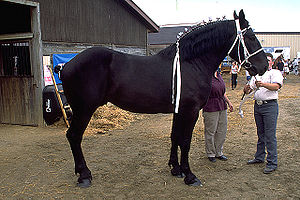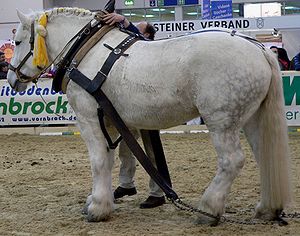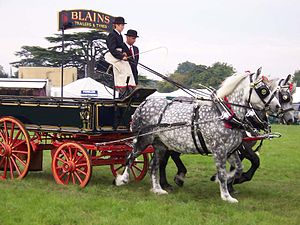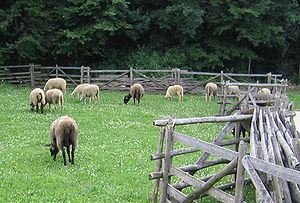Difference between revisions of "AY Honors/Livestock/Answer Key"
| Line 1: | Line 1: | ||
{{honor_header|2|1945|Nature|General Conference}} | {{honor_header|2|1945|Nature|General Conference}} | ||
(Changed from Domestic Animals) | (Changed from Domestic Animals) | ||
| − | ==1. Distinguish between the draft horse and the light horse.== | + | ==1. Distinguish between the draft horse and the light horse.== |
| + | ;Draft Horses: Draft horses are recognizable by their tall stature and extremely muscular build. In general, they tend to have a more upright shoulder, producing more upright movement and conformation that is well-suited for pulling. They tend to have short backs with very powerful hindquarters, again best suited for the purpose of pulling. Additionally, the draft breeds usually have heavy bone, and a good deal of feathering on their lower legs. Many have a straight profile or "Roman nose" (a convex profile). Draft breeds range from approximately 16 hands high to 19hh and from 1,400 to 2,000 lbs. | ||
| + | |||
| + | ;Light Horese: Light riding horses such as Arabians, Morgans, or Quarter Horses usually range in height from 14.0 (142 cm) to 16.0 hands (163 cm) and can weigh from 386 kilograms to about 540 kg (850 to 1200 lb). Larger riding horses such as Thoroughbreds, American Saddlebreds or Warmbloods usually start at about 15.2 hands (157 cm) and often are as tall as 17 hands (172 cm), weighing from 500 kg to 680 kg (1100 lb to 1500 lb). | ||
| + | |||
==2. Identify from pictures or personal observation, and record the height, weight, color, and disposition of at least three of the following horses:== | ==2. Identify from pictures or personal observation, and record the height, weight, color, and disposition of at least three of the following horses:== | ||
===a. Percheron=== | ===a. Percheron=== | ||
Revision as of 02:01, 2 February 2008
Template:Honor header (Changed from Domestic Animals)
1. Distinguish between the draft horse and the light horse.
- Draft Horses
- Draft horses are recognizable by their tall stature and extremely muscular build. In general, they tend to have a more upright shoulder, producing more upright movement and conformation that is well-suited for pulling. They tend to have short backs with very powerful hindquarters, again best suited for the purpose of pulling. Additionally, the draft breeds usually have heavy bone, and a good deal of feathering on their lower legs. Many have a straight profile or "Roman nose" (a convex profile). Draft breeds range from approximately 16 hands high to 19hh and from 1,400 to 2,000 lbs.
- Light Horese
- Light riding horses such as Arabians, Morgans, or Quarter Horses usually range in height from 14.0 (142 cm) to 16.0 hands (163 cm) and can weigh from 386 kilograms to about 540 kg (850 to 1200 lb). Larger riding horses such as Thoroughbreds, American Saddlebreds or Warmbloods usually start at about 15.2 hands (157 cm) and often are as tall as 17 hands (172 cm), weighing from 500 kg to 680 kg (1100 lb to 1500 lb).
2. Identify from pictures or personal observation, and record the height, weight, color, and disposition of at least three of the following horses:
a. Percheron
Percheron
The Percheron is a breed of powerful rugged draft horses that originated in the Perche valley in northern France.
Percherons are noted for heavy muscling and for an aspect of ruggedness and power. Also characteristic of the Percheron is clean action and quality conformation of the feet and legs. The mane is thick, though the tail is usually cut short. The breed is close coupled, wide and deep through the chest, with plenty of back rib. The muscles of the forearms, croup and gaskins are especially emphasized in a good drafter, and ease and balance of gait is essential. The horse is also expected to be of good temperament and be an easy keeper.
The Percheron head and neck is typical of the correct draft horse. Good Percherons have a large and full prominent eye, a broad and full forehead, and straight face. A wide jaw and refined ears attractively set and carried with animation are visible evidence of the Percheron's Arabian ancestry. Stallions should have a ruggedness about the head and mares should have a feminine look. The neck is well-shaped and powerful.
The Percheron has a very pleasing disposition, and is proud, alert, and intelligent. They are generally very gentle horses, well-suited for driving, and are strong and willing workers. The Percheron is readily adapted to varying climates and conditions. They have the strength to pull heavy loads and the graceful style to pull a fine carriage. Percherons can be ridden and some have even been trained to jump.
Percherons range in height from 15 to 19 hands high, most are between 16-2 and 17-3 hands high. They can weigh up to 2,600 pounds with the average around 1,900. One of the tallest horses on record was a Percheron named Dr Le Gear. Foaled in 1902, he stood 21.1 hands (7 feet) at the withers and weighed just under 1,370 kg.
Percherons are generally black or gray. Some registries only accept those two colors, though chestnut, sorrel, and bay colors are acceptable for registration in the US with a DNA test confirming their parentage. Gray and black are produced by dominant genes. The red gene for chestnut is recessive, and a red foal can only result from the mating of two black horses if they are heterozygous, having the red gene present in both sire and dam, and even then it is only a one in four chance that a chestnut will be produced. (See equine coat color genetics)
Some Percherons have white markings on the head and feet, but excessive white is undesirable.
b. Belgina
c. Clydesdale
d. Arabian
e. Shetland
3. List four physical characteristics of the mule.
- Mules are almost always sterile. They are a cross between a male donkey and a female horse. The sterility is attributed to the different number of chromosomes the two species have: donkeys have 62 chromosomes, while horses have 64. Their offspring thus have 63 chromosomes which cannot evenly divide.
- Mules are generally considered to be more intelligent than either horses or donkeys.
- Its short thick head, long ears, thin limbs, small narrow hooves, short mane, absence of chestnuts (horny growths) inside the hocks, and tail hairless at the root, make the mule look like a donkey.
- Its height and body, shape of neck and croup, uniformity of coat, and teeth, make it look like a horse.
- The mule possesses the sobriety, patience, endurance and sure-footedness of the donkey, and the vigour, strength and courage of the horse.
- Their hooves are harder than horses, and they show a natural resistance to disease and insects.
- They are capable of striking out with any of their hooves in any direction.
4. Identify a burro from a picture or live. Give its size, color, and usefulness.
5. Identify from pictures or live animals four kinds of milk cattle and four kinds of beef cattle.
Milk Cattle
Adventist Youth Honors Answer Book/Dairy cattle breeds
Beef Cattle
Adventist Youth Honors Answer Book/Beef cattle breeds
6. Know the milk-producing qualities of the Jersey, Guernsey, and Holstein breeds.
7. What is the difference between the Angora and milch goats? Give the distinguishing colors of at least three different breeds of goats, such as Saanen, Toggenburg, Nubian, and British Alpine.
8. Identify from pictures or live sheep and note wool and meat production, size, markings, and general appearance of three breeds of sheep, such as Merino, Rambouillet, Shropshire, Hampshire, and Lincoln.
Merino
The merino is the most numerous breed of sheep in the world. It is a breed prized for its wool, although more recently the low price of wool has led to more of an emphasis on its meat. Super fine merinos are regarded as having the finest and softest wool of any sheep.
Rambouillet
Shropshire
Hampshire,




